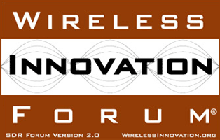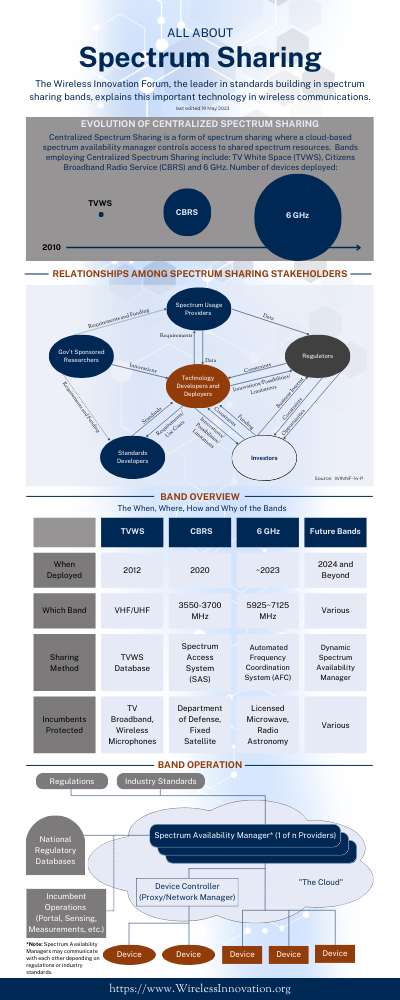[Return to main Advocacy Agenda page]
Spectrum is divided into three categories:
Click each category to go to that section.
-----
3.1 Regulatory
The Forum believes that the current model of dedicated licensed spectrum is necessary for the operation of essential and mission critical communication as well as for vital commercial communications systems; however, optimal utilization of spectrum resources can only be achieved through a combination of licensed, unlicensed, and shared spectrum access regulatory structures. Furthermore, the Forum believes that reallocation of spectrum is not a sustainable basis for sound spectrum policy.
3.1.1 Dedicated Spectrum for Essential and Critical Communications
The Forum advocates for dedicated spectrum for Essential and Critical communications. Dedicated spectrum is critical to the development and operation of essential and critical communications systems to support, for example; first responders, state and local public safety communities and federal Homeland Security networks. The need for immediate and prioritized access to spectrum, in emergency/crisis situations, can only be met by exclusively authorized (licensed or assigned) spectrum.
Commercially operated communications systems require similar dedicated access to exclusive-use spectrum to build the necessary business case for predictable service delivery to prospective consumers. Without a business case, founded on dedicated spectrum, commercial operators will not be able to make the large investments necessary to deliver national broadband wireless services as called for by the FCC.
3.1.2 Technology / Service Neutrality
The Forum advocates for technology and service neutrality to enable innovative and efficient use of spectrum. While supporting a regulatory framework of dedicated, licensed spectrum, the Forum believes that increased neutrality with respect to the specific uses of licensed spectrum will result in increased innovation in wireless applications. For example, mandating specific technology restrictions negatively impacts continued use of second-generation commercial wireless technology. In some jurisdictions, regulations still require that commercial wireless operators use Global System for Mobile Communication (GSM) in certain bands. However, no reason exists today for precluding operators from using other air interfaces within these bands.11 SDR base station technology can support multiple technologies using the same hardware, dynamically assigning channels in a manner that avoids any interference between them.
3.1.3 Multiple Licensing Models Necessary
The Forum advocates a regulatory model that includes combinations of licensed and unlicensed, sharing and hierarchical, cooperative and co-existent domains for the optimal utilization of spectrum. This approach will also permit the use of spectrum that is currently unavailable due to warehousing or is no longer used though the license remains active. While exclusive-use spectrum is a necessary regulatory condition, it is insufficient to ensure that national spectrum resources are optimally leveraged to maximum benefit. The integration of unlicensed access models and establishment of new spectrum sharing regulations, including increased tolerance of nominal levels of interference where appropriate, coupled with effective interference resolution processes are critical.
Assessment of the impact of spectrum sharing on unique legacy system that are unable to augment their systems performance must be addressed by regulatory agencies. An example of such a system is the National Science Foundation (NSF) National Radio Astronomy Observatory at Green Bank West Virginia; they may need an increase in their radio exclusion zone to mitigate the impacts.
3.1.4 Reallocation of Spectrum
The Forum believes that reallocation of spectrum is not a sustainable basis for sound spectrum policy. It is therefore of interest to regulators that the burden on existing allocations be alleviated by a variety of techniques that include efficiency measures, technology improvements leading to repacking of spectrum, incentives from one service to another to cause incumbents to move, and spectrum sharing on a flexible or secondary basis with other incumbents. A number of regulatory mechanisms exist to increase the shared use and access of selected bands, while continuing to ensure that systems can operate without disruption or harmful interference.
3.1.5 Minimize Technical Restrictions on Spectrum
The Forum advocates allocating spectrum with licenses adapted towards a spectrum usage rights method that has the minimum necessary technical restrictions to provide adequate protection
against harmful interference. Optimal use of radio spectrum is more likely to be secured if the market, and not the regulator, decides what technology or service should be provided in a particular frequency band. The increase in users’ flexibility and ability to respond faster to changing market and deployment conditions will enhance the ability to increase spectrum usage efficiency. Licenses should not necessarily restrict the technology or application. 12
3.1.6 Spectrum Access Databases
3.1.7 The Forum advocates the unified active management of spectrum (terrestrial / air / space / maritime) to maximize spectrum utilization. The use of spectrum access databases is one important tool to enable increased sharing and thereby increase the dynamic nature of spectrum management. Spectrum Licensing Systems
The Forum advocates the modernization of regulatory licensing database capability to fully realize the potential of spectrum sharing. Regulators already use databases to enable spectrum access while minimizing interference. Examples include the USA FCC’s Universal Licensing System (ULS), Canada’s ISED’s Spectrum Management System (SMS) and UK OFCOM’s Spectrum Information System (SIS). However, these regulatory databases are not always adequate, accurate and up to date. For instance, they may lack comprehensive technical data required to perform accurate interference analysis by a spectrum access or frequency coordination system in shared spectrum bands.
3.1.8 Receiver Performance Critical Consideration of Spectrum Allocations
The Forum advocates the use of receiver characteristics as part of the analysis of spectrum allocations. The Forum believes that the traditional regulatory focus on transmitter emissions is insufficient to deconflict increasingly complex services within and across band allocations. The protection requirements for existing wireless communications deployments with poor receiver performance reduce the opportunity to deploy new products and services in common or adjacent spectrum segments.13
[TOP]
3.2 Technology
The Forum advocates for further research and development of technologies that will improve the utilization of both managed and unmanaged spectrum. Techniques such as networked databases and spectrum sensing provide real-time spectrum information that can be used in dynamic spectrum access. Small cell technology and spectrum etiquettes can be used to enable fair and efficient access to shared spectrum resources.
3.2.1 Manage spectrum access via networked databases
The Forum strongly supports the use of networked and synchronized databases accessed with device location information. These databases have emerged as a critical technology for enabling and managing spectrum access (e.g., [Television White Space (TVWS) and Citizen’s Broadband Radio Service (CBRS)]).
Basing management and policy decisions in networked and synchronized databases allow regulations and services to adapt over time and vary by band while protecting incumbent users. Networked databases provide access to information beyond what is immediately observable by a radio, thereby mitigating hidden node problems in spectrum sharing scenarios. They provide a simpler mechanism for managing upgrades to spectrum management and dynamic access schemes by updating rules in a small set of databases rather than in millions of individual radios.
Furthermore, this approach has additional foreseeable benefits in that it starts the community down a path towards gathering real-time spectrum information and awareness from many distributed users, thereby helping to achieve the real-time spectrum dashboard vision endorsed by the Forum. It also simplifies the integration and application of non-spectrum domain information into spectrum management decisions, and such a solution should scale well over time.
Databases could be made an integral part of a coexistence architecture given their visibility into the locations and operational states of many different radios from disparate wireless networks. Such a solution would need relatively rapid database responsiveness to account for changing environmental conditions. This could be helped by adopting a hierarchical architecture of databases with local caching.
However, the Forum notes that managing spectrum access in such a manner should account for the following considerations.
- The possibility of a catastrophic single-point of failure implies that the system should have redundancies built in.
- The possibility of disparate information leading to conflicting and potentially difficult to trace decisions means that these multiple redundant databases should be well-synchronized.
- Spectrum sharing systems leveraging networked databases have a greater need for secure communications and authentication due to the potential for impacting a large number of systems.
- Further, as with all databases, there exists the possibility of incomplete or erroneous information.
Thus there is value to incorporating fail-safe mechanisms, such as spectrum sensing, which could provide a mechanism for assessing the presence of protected users independently of databases.
3.2.2 Spectrum Sensing
The Forum recommends that advances in spectrum sensing technologies not be discounted in future regulatory and system planning.
A Spectrum Sensing Device intelligently detects whether a band of electromagnetic spectrum within radio frequencies is currently in use. Technologies for Spectrum Sensing include both non-Cooperative (e.g. matched filters, energy detection, cyclostationary analysis, wavelet analysis, and covariance detection) and Cooperative sensing. Cooperative sensing helps to improve detection by providing readings from multiple users who collaborate with each other to refine non-cooperative spectrum sensing devices. Cooperative sensing provides both users and network administrators an appropriate spectrum context for implementation and optimization of policy based spectrum management. Multiple independent observations may be useful in identifying hidden nodes, minimizing false alarms, and may provide more accurate signal detection.
3.2.3 Spectrum Sharing and Small Cell Technologies
The Forum advocates the use of spectrum sharing and small cell technologies. The Forum believes that clearing and reallocating Federal Spectrum is not a sustainable basis for spectrum policy due to high cost, length of time to implement and disruption to the mission of essential and critical communications. The Forum recommends the use of new technologies, and paradigms such as spectrum sharing and small cells that address the emerging spectrum crisis.14
3.2.4 Spectrum Etiquette
The Forum considers spectrum etiquettes an important regulatory tool for maximizing the economic and social benefit of the electromagnetic spectrum. Spectrum etiquettes determine principles of operation which the radio must consider when making its decisions, and offer a means to share spectrum resources in an efficient and fair manner15. The Forum believes that rules defining performance criteria for spectrum etiquettes may need to be promulgated in order for the benefits of spectrum etiquettes to be realized, but that the etiquettes themselves need not be regulated16. The Forum also encourages open testing and simulation of etiquettes to facilitate innovation that would improve spectrum efficiency and to assure that etiquette performance objectives are being met.
3.2.5 Cooperative Sharing
The Forum advocates legacy users augmenting their existing systems, where possible to facilitate cooperative sharing of spectrum. There is an inherent inefficiency of spectrum etiquettes that do not account for the presence or behavior of other radio systems. To share spectrum, radio systems’ operational parameters are implemented so both systems have access to the spectrum. While many parameters such as transmitted power (e.g., transmit power control), frequency (e.g., dynamic frequency selection) and time (e.g., predictive scheduling) directly impact coexistence metrics and are obvious candidates for cognitive radio control, many other parameters can be set to ensure and enhance coexistence such as route selection (choosing routes to minimize interference), network association (preferentially connecting to a network with greater protective measures), and application layer parameters (such as reducing video quality which reduces occupied bandwidth)17. Conceptually, virtually every parameter, setting, and/or process which influences the transceiver operations of a radio can be controlled to ensure or enhance the coexistence of cognitive radio systems with other users.
Out of necessity, most proposed techniques for gaining information about legacy systems (e.g., TV or satellite) adopt a non-cooperative approach, where the cognitive radio system has to gain relevant information without help from the incumbent. Cooperative techniques such as has been proposed for systems utilizing a Radio Environment Map database are therefore generally limited to use for coexistence between cognitive radio systems accessing available “white space”. However, this need not be the case as with the proper inducements, legacy users could augment their existing systems to aid cognitive radio systems’ observation and orientation processes. This includes registering accurate transmitter and receiver characteristics for legacy radio systems with the radio environment map database.18
The members of the Forum endorse this approach, which allow for the design, development and standardization of a “spectrum dashboard” providing a real time or near real time view of the radio environment map at a given location and at a given time. Such a dashboard will be a key tool in determining the etiquettes that the cognitive radio must consider when making its decisions.
[TOP]
3.3 Standards
3.3.1 Harmonized Standards
The Forum considers harmonized standards to be an important stepping-stone toward the broad deployment of wireless communications worldwide. Harmonized standards can benefit five key players in the wireless communications value chain:
- Developers benefit from minimal risk in new product development and service development
- Manufacturers benefit from a single set of technical requirements and an increased range of potential customers across a wider range of countries
- Network operators benefit from having an increased range of equipment manufacturers and an increased customer base
- Consumers benefit from the opportunity to purchase equipment from a wide range of manufacturers and can have a better choice in the price that they are willing to pay
- Investors benefit from an increased market size, cost reductions, and risk minimization
3.3.2 Spectrum System Interfaces
The Forum advocates the use of existing and emerging transmit, receive and interference regulatory standards to facilitate use of Spectrum System Interfaces (SSI), such as the CBRS Spectrum Access System (SAS) to CBRS Device (CBSD) and CBRS SAS to SAS interfaces developed by the Wireless Innovation Forum, that enable a wide range of spectrum sharing opportunities. Spectrum sharing between legacy communication platforms and modern advanced wireless systems requires clear and accurate standards development, compliance and harmonization. The Forum is committed to development of regulatory standard that enable efficient use and repurposing of spectrum. New regulation should enable and encourage innovation in both commercial and mission critical communications as technology for radios, networks and users continue to evolve.
The Forum believes a key principle of well-defined and enforced spectrum regulation is to “do no harm” to legacy users, operators, or commercial and mission critical communications developers that provide new products capable of spectrum sharing and innovations needed to improve spectrum utilization.
- Transmitter Standards: Legacy transmitter standards for both commercial and mission critical communications evolved over the years without a requirement for spectrum sharing. For the most part transmitter standards specify static behavior of the in-band and out-of-band characteristic of a transmitter used in an assigned spectrum allocation. The Forum believes as industry provides cognitive and policy-based communication systems capable of adaptation to its own RF environment, transmitter standard will need to be harmonized with diverse user requirements to support spectrum sharing and needed improvements in spectral efficiency.
- Receiver Standards: Dedicated spectrum license policies and lack of legacy receiver standards encouraged development and deployment of low-cost receiver technology that in many cases lack the robustness necessary to allow spectrum sharing. The Forum believes development of receiver standards is critical to support both spectrum repurposing and sharing. Forum sponsored projects on receiver standards are in place and will address the role of receiver standards in preparing for next generation innovation and advancement in communication technology for both dedicated and shared spectrum.
- Interference Standards: The Forum believes development of interference standards that harmonize transmit and receive standards with Spectrum Consumption Models (SCM), Model-Based Spectrum Management (MBSM) systems, geolocation databases and user access policies will be required to fully implement proposed regulations for repurposing and sharing of licensed and unlicensed spectrum.
The Forum believes support, development and harmonization of appropriate transmit, receive and interference standards are critical enable spectrum managers to optimize spectrum utilization for ALL commercial and mission critical communication platforms.
3.3.3 Receiver Standards
The Forum believes that the role of receiver parameters in standards and their related consideration in spectrum engineering should receive greater prominence in order to enhance spectrum efficiency and to help maximize value to the economy and society.
- The Forum believes much benefit can be achieved in terms of spectrum efficiency through this approach while at the same time reducing risk for new market and new technology entrants19
- Receiver parameters play a fundamental role in flexible spectrum usage and management because the defined protection approaches are a function of the receiver parameters e.g. sensitivity, blocking, and protection ratios
- Improvements in technology and manufacturing processes have greatly reduced the costs for components designed to improve receiver performance. It is the Forum’s belief that there is now little or no economic penalty for improving receiver performance in new products.
- Furthermore, the Forum believes that the protection of an existing wireless communications system with a poor receiver performance would hamper the introduction of a new technology.
- Receiver parameters included in harmonized standards would have an impact on equipment specifications, which would improve the performance of existing radio applications and further support the deployment of new wireless communications products and services.
[TOP]
-----
11 such as LTE, 802.11af or proprietary air interfaces
12 Ofcom UK http://stakeholders.ofcom.org.uk/binaries/consultations/surs/summary/surs.pdf
13 FCC Technical Advisory Council, Sharing Work Group, “Case Studies: The Role of Receiver Performance In Promoting Efficient Use of the Spectrum,” Appendix C in Spectrum Efficiency Metrics White Paper, Version 1.0, 10 December 2011.
http://transition.fcc.gov/oet/tac/tacdocs/tac-meeting-summary-12-20-11-final.pdf
14 Wireless Innovation Forum Announces Broad Support of the PCAST Recommendations on Spectrum Sharing; https://www.wirelessinnovation.org/assets/work_products/Recommendations/winnf-12-r-0004-
v1.0.0%20winnforum%20position%20on%20pcast%20report%20on%20spectrum%20sharing.pdf
15 Software Defined Radio (SDR) Forum Comments on The FCC Memorandum Opinion and Order (MO&O) and Further Notice of Proposed Rulemaking (NPRM) Adopted June 19, 2007; https://www.wirelessinnovation.org/assets/work_products/Recommendations/sdrf-07-r-0023-v0_0_sdr_forum_spectrum_etiquette_fcc_07-117_final.pdf
16 Ibid
17 Working Document Towards a Preliminary Draft New Report on Cognitive Radio in Land Mobile Service, SDRF-08-R-0001-V1.0.0, https://www.wirelessinnovation.org/assets/work_products/Recommendations/sdrf-08-r-0001-v001-itu_wp5a_cr_responses_final.pdf
18 Wireless Innovation Forum Announces Broad Support of the PCAST Recommendations on Spectrum Sharing, WINNF-12-R-0004-V1.0.0, https://www.wirelessinnovation.org/assets/work_products/Recommendations/winnf-12-r-0004-
v1.0.0%20winnforum%20position%20on%20pcast%20report%20on%20spectrum%20sharing.pdf
19 Electronic Communications Committee, The Impact of Receiver Standards on Spectrum Management, http://www.erodocdb.dk/docs/doc98/official/pdf/ECCRep127.pdf
[Return to main Advocacy Agenda page]
WINNF Advocacy Agenda WINNF-RC-0007-V1.0.0
Copyright © 2021 The Software Defined Radio Forum Inc.
All Rights Reserved



